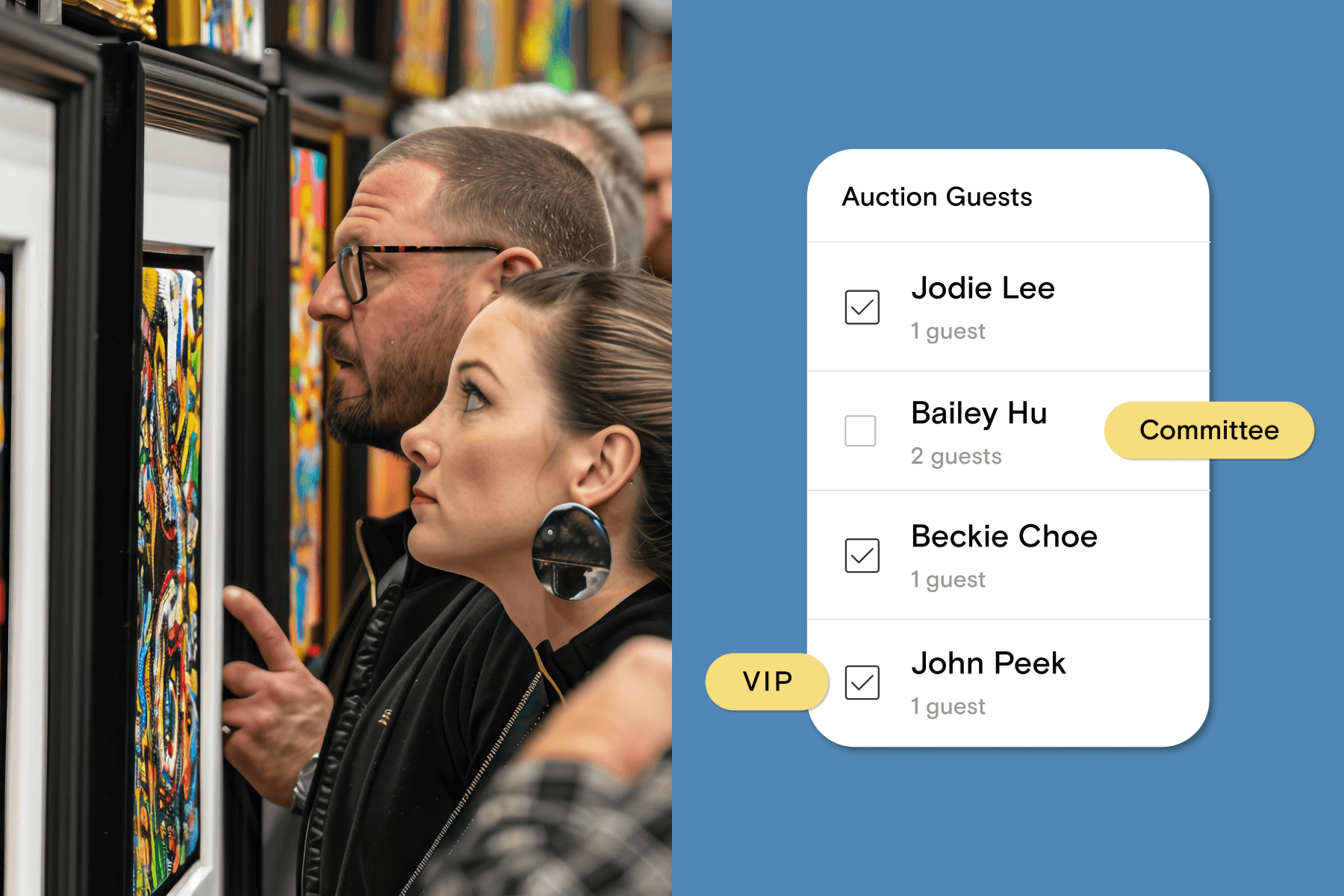How to successfully run a silent auction in 12 steps

Hosting a silent auction is an effective and exciting way to get everyone involved in your fundraiser—and to raise more money than ever. Silent auctions let guests quietly compete, using timing and strategy to win the big prize they’re eyeing. It’s a great event to hold on its own, or as part of a larger event. Either way, Paperless Pro can help you through the process. Plus, we’ve asked Rene Petties-Jones, President at NFJC of WNY, Inc., for tips on how to conduct a silent auction that everyone—including the host—enjoys as much as possible.
Table of Contents
How do silent auctions work?
Unlike live auctions where guests call out bids on items in real time, silent auctions let attendees quietly bid on items over a longer period. Guests typically walk through an area of an event to look at items available for auction, such as physical items—like gift baskets or bottles of wine—as well as larger prizes (sometimes represented by a smaller item like a miniature airplane to represent a trip).
“Success is in the details of the event,” says Rene Petties-Jones. “You want to make it easy to access, see, and read about all of the items up for auction.”
Most silent auctions use these bidding methods:
- Paper bidding: To set up paper bidding, place silent auction bid sheets next to the physical auction items. Add a starting bid—usually less than the value of the item. Guests either write down their name or an assigned number on the bid sheet, along with their new increased bid. The last name on the sheet when the auction closes is the winner.
- Mobile bidding: This works best with a silent auction app that lists each item up for bid. Guests can then download the app and place their bids through their phone instead of on paper. The app will automatically stop taking bids when the auction closes.
- Online bidding: Instead of physical items at the venue—or in addition to physical items—an online auction app lists bigger items or packages that guests can also bid on. Even guests who aren’t present at the event can participate in online bidding.
The type of bidding you use depends on the type of fundraising event you’re hosting. Paper bidding puts more focus on the auction, since guests need to monitor the items they want, to ensure they’re not outbid. Mobile bidding lets guests mingle as they check bids on their phones, and online bidding encourages remote guests to participate in the silent auction, which can increase the amount of money made at the event.
Silent auction item ideas

The best silent auctions have a variety of gifts in a variety of price points. You can ask members of your planning committee to donate items or reach out to the community to gather items they can donate.
Popular ideas for silent auction items, as well as silent auction basket ideas, include:
- Gift cards to local restaurants or stores
- Themed baskets (coffee lover, movie night, wine tasting)
- Vacations or hotel stays
- Personal experiences (music lessons from a local musician, a personal meal prepared by a chef)
- Classes at a gym or studio
- One-month membership to a spa, gym, or other facility
- Cakes or dessert plates
- Free passes to an activity or summer camp for kids
How to run a silent auction
If you’re planning a silent auction as an activity within a larger event—or if the silent auction itself is the main event—there are a few key steps that’ll help you make it successful.
1. Create a committee
A silent auction needs its own committee, regardless of where it falls in the main event. The committee will examine the objectives and goals of the auction.
“Do we need to raise dollars, elevate a mission, or do a friend-raiser in addition to the fundraising?” asks Ms. Petties-Jones. “Understanding your goals and objectives first allows you to get creative later.”
Common committee roles could include:
- Chair: Coordinates communication between the rest of the committee members at and between committee meetings.
- Vice-chair: Plans and schedules meetings and oversees other committee members as they complete tasks.
- Treasurer: Manages the auction budget and prepares financial statements before and after the event.
- Secretary: Keeps minutes and detailed notes of meetings, including event updates and member questions.
- Donation coordinator: Follows leads and reaches out to community members for items to auction off as well as monetary sponsorships.
- Vendor coordinator: Handles communications with all vendors, including venue managers, caterers, musicians, DJs, and servers.
- Bid-sheet coordinator: Leads a small team in setting starting bids for each item and adding them to the bid sheets.
- Auction set-up: Arranges for volunteers to arrive early and set up the auction items and decorate the party space.
- Auction clean-up: Arranges for volunteers to stay late and clean up the party space, including gathering auction items and labeling them with their winners.
Ms. Petties-Jones also suggests that committees learn by example when it comes to planning. “Look at other silent auctions,” she recommends. “It’s a great way to learn about the pluses and the minuses of this type of event. Then, try to think of something that your potential donors or supporters may not have seen.”
2. Set a budget
Auction committees also create a budget based on the event’s objectives and the fundraising goal. “For me, 50% of the goal is my bottom line,” says Ms. Petties-Jones. “I call 75% a win. Anything beyond that is a super win.”
Remember to budget out items like:
- Food and drinks
- Decorations
- Staff or other vendors
- Venue
- Furniture rentals
- Technology needs (like bidding apps)
- Audio/visual equipment (microphones, amps, speakers)
3. Ask for donated prizes
When asking donors or sponsors for prizes to auction off, Ms. Petties-Jones says that you should tell your story. “Be authentic in how you articulate your mission and goals, and your vision to get to those goals,” she advises. Donors are more likely to give to a cause they believe in, so draw them into your goals from the start.
Ms. Petties-Jones also suggests leaving room in your timeline to secure and gather the donations themselves. “Give yourself at least three months between solicitation and the actual picking up of the item because you’ve got to build that into a lot of different layers of the event planning.”
4. Secure the logistics
Silent auctions that are part of a larger event should already have the basics in place (venue, refreshments), but the auction has its own logistical needs, too. If you’re using bidding apps, research and pay for them before the event begins. Decide where your silent auction will take place in your venue and if you’d like guests to bid remotely.
Ms. Petties-Jones warns that “Security has been an issue in recent years. We prefer to have strategic law enforcement partners that are placed throughout the event so that we know that our items are watched. We’ve also enlisted the help of our volunteer base to stay close to where our higher value items are.”
She also offers this tip: “One of the things that we’ve done is have a separate area where we store the actual auction item. Then, we bring out the item when it is fully paid for and the winner is ready to take it. This is an example of security that you can implement that’s fairly easy and not obtrusive to your guests.”
Don’t forget to choose how you’ll announce the winners—will you call them out during the event, list them on social media, or simply reach out to each person who won?
5. Invite guests
It’s time for the fun part! Choose an fundraiser invitation design that reflects your organization. Then, add custom colors and your logo to highlight your brand. Ms. Petties-Jones also recommends making your auction invitation as clear as possible. “You have to make sure the date and time are clearly stated,” she says. “With Paperless Post, it’s nice that you can create a draft and leave it in the queue for others on your team to proofread before sending.”

To better organize all the information that your guests need to know, add Blocks, including a Sponsors Block to highlight your sponsors and their company logos, as well as a Photo Gallery Block to show your organization in action in the community. If you’d like to add even more details, like your organization’s website or an online silent auction page that guests can access right after they RSVP, use a Link Block so it’s easy for guests to find.
Once everything in your invitation is ready to go, upload a list of contacts so you can send it out to everyone you know. Or post a shareable link to the invitation on your social media channels. Use Paperless Pro’s guest management tools, such as advanced Analytics for RSVPs, to stay on top of your guest list before the big day.
Ms. Petties-Jones suggests sending invitations out “at least two months in advance, particularly if your event is hitting around the peak seasons. If it’s during a quieter time of year, you might be able to get away with six weeks.”
6. Set up the auction

As you start to place your items, Ms. Petties-Jones says “The easiest way to plan a successful silent auction is to put yourself into the mind of your guests. How would you want to go from A to Z in the event? What would you need along the way?”
It’s important to also make your items attractive and easy to navigate. “We put a lot of effort into staging,” says Ms. Petties-Jones. “An immersive view can really draw you in to say, ‘What’s that item? Let me go check that out.’”
If you have items that are difficult to display, use smaller objects to represent them. “We had some cute little fun props that went along with each item,” says Ms. Petties-Jones. “For example, airline tickets or wine glasses for trips and wine tastings.”
When pricing your silent auction items, set them on the lower side—25–50% of their total value at most—so guests are eager to win the prize at a deal.
7. Monitor bidding

Silent auctions tend to run themselves—that’s their appeal, after all. But there’s a level of monitoring you’ll need to do during the bidding process.
- Check in guests using the Paperless Post app so you know who’s arrived and is ready to bid.
- If you’re using paper bidding, take a walk around the tables to make sure people are increasing bids. Encourage guests to place bids on items that haven’t been bid on yet.
- For silent auctions that use an app, ensure that the software is running and that everyone knows how to use it. Post instructions for guests who may need assistance, or have committee members ready to help with technological difficulties.
8. Close the bidding
Everyone’s bidding up a storm—but the fun has to end sometime. End your auction two or three hours after it begins. A few minutes before closing time, have the emcee remind guests that bidding is about to end. Then, let guests make their final bids. Apps should stop taking bids at the moment the auction ends, while committee members pick up bid sheets for paper bidding.
9. Determine the winners
Once the auction is officially over, compile winners into a list and let them know they’ve won. You can do this by announcing winners at the event itself, emailing winners after the event is over, or posting a list online.
Bidding apps will typically collect this information for you and send winners the results of the auctions they’ve won.
10. Collect donated funds
An advantage of bidding apps is that they collect bids from users via credit cards and let hosts know who’s paid for their prizes. If you use paper bidding, you’ll need to reach out to winners for payment—either by check, cash, or credit card—and keep track of who hasn’t yet paid.
If winners haven’t paid after a certain time, let them know you’re going to move to the second-place winner before offering them one last chance to pay their bid instead.
11. Get prizes to the winners
If it’s possible, hand out physical prizes to the winners before they leave the event—especially if they’re from out of town. Winners who don’t collect their prizes can pick them up at a central location, such as your organization’s headquarters or a committee member’s home. You can also enlist committee members to deliver unclaimed prizes to the winners.
12. Send thank you notes

“Everybody who participated should get a ‘thank you’ of some sort,” says Ms. Petties-Jones. That includes event sponsors, prize donors, and all guests who placed bids—and even the ones who didn’t. Send thank you cards and mention how much you raised at your event, what you’ll use the funds for, and your organization’s next events, so they can put them on their calendar.
If you used Paperless Post for your invitations, you’ve already got all the contact information you need to send each guest a heartfelt thank you. That information will also come in handy for planning your next event.
Silent auction FAQs
Silent auctions run like clockwork when they’re planned well. Find the answers to any other questions you have about silent auctions to ensure your event runs as smoothly as possible.
Is a silent auction really silent?
Silent auctions are called “silent” because the bidding takes place silently, either on paper or through bidding apps. But the event itself doesn’t need to be silent!
Feel free to book a live band, a DJ, or any other entertainment, and let guests chat and mingle during the bidding. The more fun they’re having, the higher they’ll bid!
What are common silent auction rules?
Though you can set any silent auction rules you like, guests may be more familiar with common ones like:
- Respect bid increments: You can set increment amounts by which guests can increase their bids (such as $15) to avoid people adding small, one-penny bids to beat the previous one. Low-bid increments take up too much time and don’t lead to large donations to your cause.
- Only bid for yourself: Unlike live auctions, where you can bid for other people, silent auctions work best when everyone bids for themselves. If you have guests who can’t attend, consider implementing online bidding so everyone can participate.
- Winners must be present: If you set this rule, make it clear from the beginning that guests must be present at the end of the auction in order to win their prize. If they’re not, the prize goes to the next highest bidder.
- Sales are final: Because items are donations, guests should not expect to receive a refund from the auction committee or the donor. Make it clear that when a guest adds a bid, they’re committing to buy that item at that cost—unless someone outbids them, of course.
Can I plan a silent auction by myself?
Because a silent auction is such a detailed event, it’s advisable to plan it with more than one person. Planning the logistics of the auction, procuring the prizes, coordinating with vendors, and fulfilling every other task to run the event requires a team of dedicated committee members. A committee of 5–8 people is ideal, along with a team of volunteers who can help on auction day.
Bid on a good time with Paperless Pro
When it comes to running a fundraiser, Paperless Pro knows that it’s all about the details. With professional event management tools, sophisticated fundraiser invitation templates, and our guide to corporate invitation wording to capture your mission and goals in one easy message, we’ve got everything you need to throw an unforgettable—and successful—fundraiser. From planning to sending invitations, to running a successful event, Paperless Post is with you every step of the way.
Find sophisticated, business-minded designs that streamline planning and impress guests.
